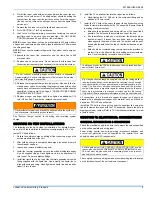
501562-UIM-A-0909
Johnson Controls Unitary Products
5
6.
Protect the vapor valve with a wet rag and braze the vapor line con-
nection to the outdoor unit. The nitrogen flow should be exiting the
system from the vapor service port connection. After this connec-
tion has cooled, remove the nitrogen source from the liquid fitting
service port.
7.
Replace the Schrader core in the liquid and vapor valves.
8.
Go to “SECTION IV” for TXV installation.
9.
Leak test all refrigerant piping connections including the service
port flare caps to be sure they are leak tight. DO NOT OVER-
TIGHTEN (between 40 and 60 inch - lbs. maximum).
NOTE:
Line set and indoor coil can be pressurized to 250 psig with dry
nitrogen and leak tested with a bubble type leak detector. Then release
the nitrogen charge.
NOTE:
Do not use the system refrigerant in the outdoor unit to purge or
leak test.
10. Evacuate the vapor line, evaporator, and the liquid line to 500
microns or less.
11. Replace cap on service ports. Do not remove the flare caps from
the service ports except when necessary for servicing the system.
12. Release the refrigerant charge into the system. Open both the liq-
uid and vapor valves by removing the plunger cap and with an allen
wrench back out counter-clockwise until valve stem just touches the
chamfered retaining wall. See Page 4 "PRECAUTIONS DURING
BRAZING SERVICE VALVE".
13. Replace plunger cap finger tight, then tighten an additional 1/12
turn (1/2 hex flat). Cap must be replaced to prevent leaks.
See "System Charge” section for checking and recording system
charge.
SECTION IV: TXV INSTALLATIONS
The following are the basic steps for installation. For detailed instruc-
tions, refer to the Installation Instructions accompanying the TXV kit.
Install TXV kit as follows:
1.
Relieve the holding charge by pulling off the rubber cap plug on the
suction manifold line of the coil.
2.
After holding charge is completely discharged, loosen and remove
the schraeder cap seal.
3.
Loosen and remove distributor cap seal.
4.
Install the thermal expansion valve to the orifice distributor assem-
bly with supplied fittings. Hand tighten and turn an additional 1/4
turn to seal. Do not overtighten fittings.
5.
Install the liquid line to the top of the thermal expansion valve with
fitting supplied with the liquid line. Hand modify the liquid line to
align with casing opening. Hand tighten the liquid line and an addi-
tional 1/4 turn to seal.
6.
Install the TXV equalizer line into the vapor line as follows:
a.
Hand tighten the 1/4” SAE nut to the schraeder fitting and an
additional 1/3 turn to seal.
7.
Install the TXV bulb to the vapor line near the equalizer line, using
the bulb clamp(s) furnished with the TXV assembly. Ensure the bulb
is making maximum contact.
a.
Bulb should be installed on a horizontal run of the vapor line if
possible. The bulb should be installed on top of the line.
b.
If bulb installation is made on a vertical run, the bulb should be
located at least 16 inches from any bend, and on the tubing
sides opposite the plane of the bend. The bulb should be posi-
tioned with the bulb tail at the top, so that the bulb acts as a res-
ervoir.
c.
Bulb should be insulated using thermal insulation provided to
protect it from the effect of the surrounding ambient tempera-
ture. Cover completely to insulate from air-stream.
All connections to be brazed are copper-to-copper and should be
brazed with a phosphorous-copper alloy material such as Silfos-5 or
equivalent. DO NOT use soft solder.
Install the TXV bulb to the vapor line near the equalizer line, using the
two bulb clamps furnished with the TXV assembly. Ensure the bulb is
making maximum contact. Refer to TXV installation instruction for view
of bulb location.
SECTION V: ELECTRICAL CONNECTIONS
GENERAL INFORMATION & GROUNDING
Check the electrical supply to be sure that it meets the values specified
on the unit nameplate and wiring label.
Power wiring, control (low voltage) wiring, disconnect switches, and
over current protection must be supplied by the installer. Wire size
should be sized per NEC requirements.
The complete connection diagram and schematic wiring label is located
on the inside surface of the unit service access panel.
Do not connect manifold gauges unless trouble is suspected.
Approximately 3/4 ounce of refrigerant will be lost each time a stan-
dard manifold gauge is connected.
Never attempt to repair any brazed connections while the system is
under pressure. Personal injury could result.
In all cases, mount the TXV bulb after vapor line is brazed and has
had sufficient time to cool.
Dry nitrogen should always be supplied through the tubing while it
is being brazed, because the temperature required is high enough
to cause oxidation of the copper unless an inert atmosphere is pro-
vided. The flow of dry nitrogen should continue until the joint has
cooled. Always use a pressure regulator and safety valve to insure
that only low pressure dry nitrogen is introduced into the tubing.
Only a small flow is necessary to displace air and prevent oxidation.
All field wiring must USE COPPER CONDUCTORS ONLY and be
in accordance with Local, National, Fire, Safety, & Electrical Codes.
This unit must be grounded with a separate ground wire in accor-
dance with the above codes.






































